Social Search Optimization: Rank #1 on TikTok, Instagram, and Pinterest in 2025
Social media platforms have evolved beyond mere networking tools to become powerful search engines in their own right. With 40% of Gen Z now using TikTok and Instagram for search instead of Google, and Pinterest processing over 5 billion monthly searches, optimizing for social search has become essential for brands seeking visibility. This comprehensive guide explores the unique optimization strategies needed to rank at the top of social search results on TikTok, Instagram, and Pinterest, helping you capture high-intent audiences where they’re actively searching.
Key Takeaways
- Platform-Specific Search Behaviors: Each social platform has unique search algorithms and user behaviors that require tailored optimization approaches.
- Visual Search Dominance: Social search prioritizes visual content, requiring optimization beyond traditional text-based SEO tactics.
- Conversational Keywords Matter: Users search differently on social platforms, using more natural language and question-based queries.
- Engagement Metrics Impact Rankings: Social search algorithms heavily weight user engagement when determining content rankings.
- Cross-Platform Strategy Required: A coordinated approach across multiple platforms maximizes visibility and reinforces search authority.
- Continuous Adaptation Essential: Social search algorithms evolve rapidly, requiring ongoing optimization and testing.
TABLE OF CONTENTS:
The Social Search Revolution
The search landscape has fundamentally changed. According to recent data, 45% of Gen Z are more likely to use “social searching” on platforms like TikTok or Instagram than traditional search engines. This shift represents more than just a change in user behavior—it’s a complete reimagining of how people discover information, products, and services.
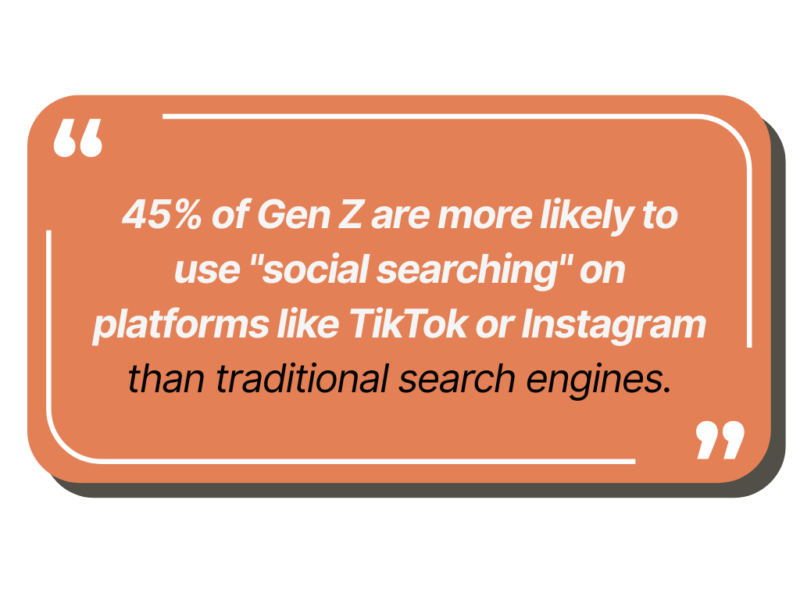
Unlike traditional search engines that prioritize text and links, social search is inherently visual, conversational, and community-driven. Users aren’t just looking for information; they’re seeking authentic experiences, recommendations, and solutions presented in engaging formats.
“Social media isn’t just for scrolling anymore—it’s for searching,” notes digital marketing expert Tamara Biljman. “In 2025, we’re seeing a major shift from passive consumption to active discovery. People are typing full queries into social apps to find product recommendations, how-tos, reviews, local spots, and more.”
This transformation presents both challenges and opportunities for brands. Those who understand and adapt to the unique characteristics of social search can gain significant competitive advantages in visibility, engagement, and conversions.
Understanding Platform-Specific Search Algorithms
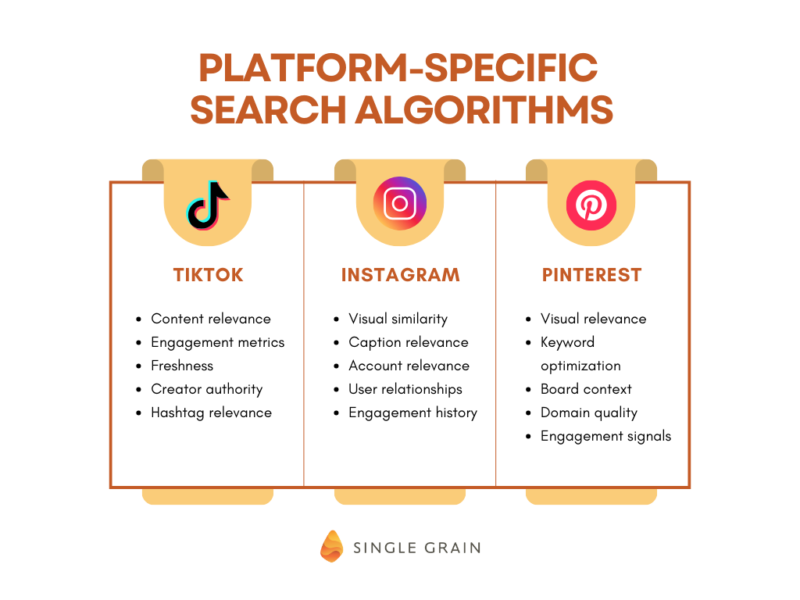
Each social platform has developed unique search algorithms, optimized for its specific content formats and user behaviors. Understanding these differences is crucial for effective optimization.
TikTok: The Visual Discovery Engine
TikTok’s search algorithm prioritizes:
- Content relevance: How closely your video matches the search query
- Engagement metrics: Views, likes, comments, shares, and completion rates
- Freshness: Recent content often receives preference
- Creator authority: Accounts with consistent engagement on similar topics
- Hashtag relevance: Strategic use of trending and niche hashtags
TikTok has emerged as a leader in the social search revolution, with 40% of Gen Z now using it as their preferred search engine for certain queries. The platform excels at surfacing authentic, visually-driven content that answers specific questions or demonstrates solutions.
Instagram: The Lifestyle Search Platform
Instagram’s search algorithm focuses on:
- Visual similarity: How your content visually relates to the search query
- Caption relevance: Keywords in your captions and alt text
- Account relevance: Your account’s overall topic focus and authority
- User relationships: Content from accounts users already engage with
- Engagement history: Consistent performance across similar content
Instagram’s Explore page has evolved into a sophisticated visual search engine, with users increasingly typing direct questions like “outfit ideas for work” or “best skincare for acne” into the search bar.
Pinterest: The Intent-Driven Visual Search
Pinterest’s search algorithm emphasizes:
- Visual relevance: How your pin visually matches search intent
- Keyword optimization: Strategic use of keywords in pin titles and descriptions
- Board context: How your pins are organized and categorized
- Domain quality: The authority of linked websites
- Engagement signals: Saves, clicks, and close-ups
With over 5 billion monthly searches, Pinterest functions more like a traditional search engine than other social platforms, but with a distinctly visual focus. Users come to Pinterest with high intent, often actively planning purchases or projects.
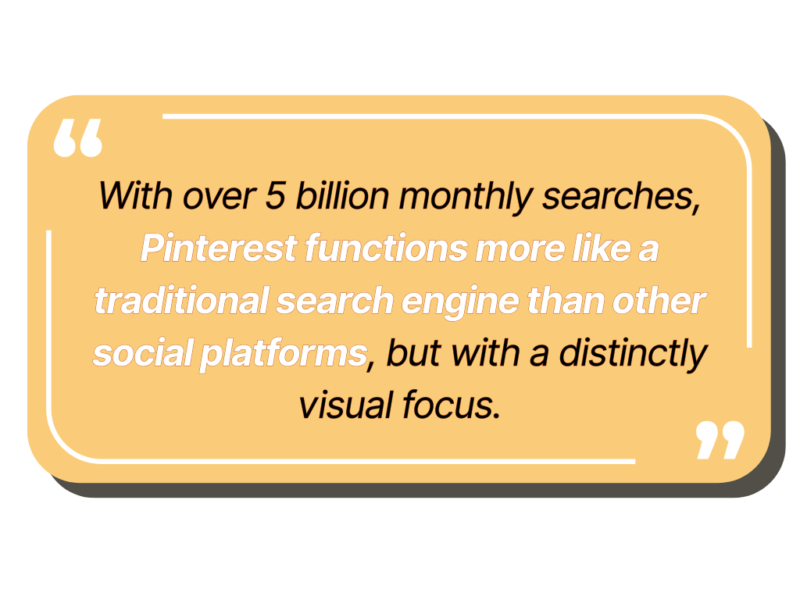
Single Grain’s SEO experts understand these platform-specific algorithms and can help you develop tailored strategies that align with each platform’s unique ranking factors.
Optimizing Content for TikTok Search
To rank #1 in TikTok searches, you need a strategy that aligns with the platform’s unique algorithm and user behavior patterns.
1. Keyword Research for TikTok
TikTok search requires a different approach to keyword research:
- Monitor the search suggestion bar: Type partial queries and note TikTok’s autocomplete suggestions
- Analyze trending hashtags: Identify relevant trending topics in your niche
- Study competitor content: Note which search terms bring up competitor videos
- Use conversational phrases: Focus on how people actually talk, not formal keywords
- Incorporate questions: Many TikTok searches are framed as questions
2. Create Search-Optimized Video Content
Once you’ve identified your target search terms, optimize your videos:
- Hook viewers in the first 3 seconds: TikTok’s algorithm favors videos with high completion rates
- Mention key search terms early: Say your target keywords out loud in the first few seconds
- Create “answer” content: Directly address common questions in your niche
- Keep videos concise: 30-60 second videos often perform best in search results
- Use on-screen text: Include key search terms as text overlays
3. Optimize Video Metadata
Beyond the video itself, optimize all supporting elements:
- Strategic caption writing: Include primary keywords naturally in your captions
- Hashtag strategy: Use a mix of broad, niche, and trending hashtags (3-5 total)
- Create a searchable series: Use consistent naming for related content
- Engage with comments: High comment engagement boosts search visibility
According to research from Brandlective Communications, “TikTok has been refining its search bar to suggest keywords, trends, and even display a ‘top searches’ section.” This makes it increasingly important to align your content with how users actually utilize the platform.
Ranking in Instagram’s Search Results

Instagram’s search functionality has evolved significantly, requiring specific optimization tactics to achieve top rankings.
1. Profile Optimization for Discoverability
Your Instagram profile serves as the foundation for search visibility:
- Keyword-rich username and display name: Include primary keywords
- Optimized bio: Incorporate relevant search terms naturally
- Consistent niche focus: Maintain topical relevance across your content
- Link utilization: Use relevant external links that reinforce your authority
2. Content Optimization Strategies
For individual posts to rank well in Instagram search:
- Front-load captions with keywords: Place important terms in the first line
- Strategic hashtag usage: Research and use a mix of popular and niche hashtags
- Alt text optimization: Add descriptive, keyword-rich alt text to all images
- Location tagging: Use location tags for local search visibility
- Mention relevant accounts: Tag accounts related to your content topic
3. Engagement Tactics for Search Visibility
Instagram’s algorithm heavily weights engagement when determining search rankings:
- Encourage meaningful comments: Ask questions that prompt detailed responses
- Respond to all comments: Build conversation threads on your posts
- Create shareable content: Design posts that users will want to save and share
- Post consistently: Maintain a regular posting schedule to build algorithmic favor
- Cross-promote across features: Use Stories, Reels, and posts to reinforce topics
“Instagram is testing improved keyword search, alt-text for visuals, and potentially post-level search filtering,” notes a recent report from Brandlective. These developments make it increasingly important to optimize all aspects of your Instagram content for searchability.
Pinterest Search Optimization Tactics
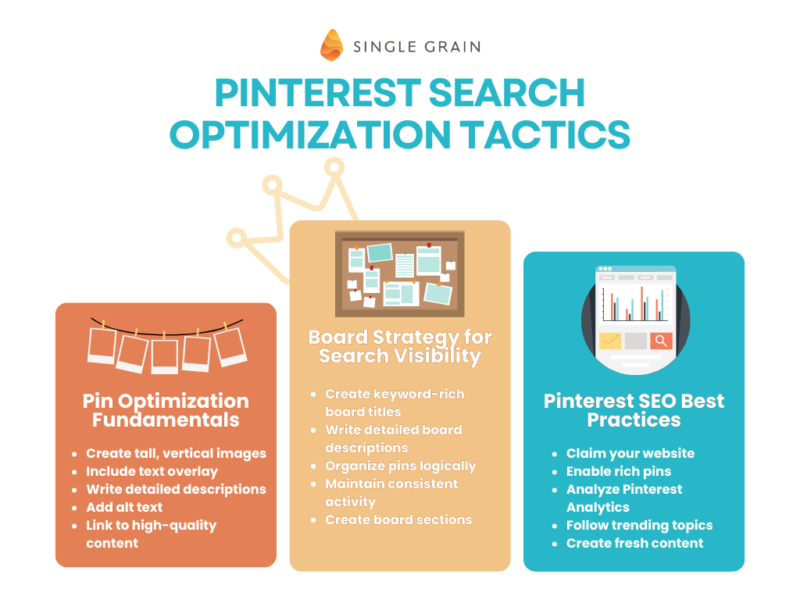
With its intent-driven user base, Pinterest offers unique opportunities for brands that understand its search ecosystem.
1. Pin Optimization Fundamentals
To rank well in Pinterest search results:
- Create tall, vertical images: Use the optimal 2:3 aspect ratio (1000 x 1500 pixels)
- Include text overlays: Add descriptive, keyword-rich text to images
- Write detailed descriptions: Use 100-200 characters with primary and secondary keywords
- Add alt text: Include descriptive alt text for all pins
- Link to high-quality content: Ensure destination URLs provide valuable content
2. Board Strategy for Search Visibility
Your board organization significantly impacts search performance:
- Create keyword-rich board titles: Use specific, searchable names
- Write detailed board descriptions: Include relevant keywords naturally
- Organize pins logically: Group related content to reinforce topical relevance
- Maintain consistent activity: Pin regularly to established boards
- Create board sections: Further organize content into searchable subcategories
3. Pinterest SEO Best Practices
Additional tactics to improve Pinterest search rankings:
- Claim your website: Verify ownership of your domain
- Enable rich pins: Provide additional metadata for your pins
- Analyze Pinterest Analytics: Identify which pins perform best in search
- Follow trending topics: Align content with seasonal and trending searches
- Create fresh content: Pinterest favors new pins over repins
“Pinterest is becoming more predictive, surfacing content based on prior activity and trending topics,” according to social search experts. This makes it essential to not only optimize for current search terms but also anticipate and create content for emerging trends.
Cross-Platform Social Search Strategy
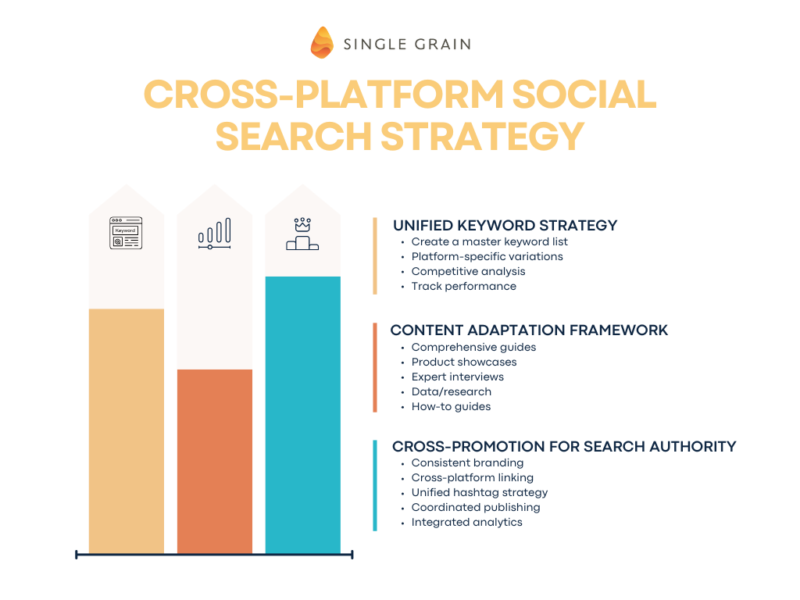
While each platform requires specific optimization tactics, a coordinated cross-platform approach maximizes your overall social search visibility.
1. Unified Keyword Strategy
Develop a comprehensive keyword approach that works across platforms:
- Create a master keyword list: Identify terms relevant across all platforms
- Platform-specific variations: Adapt language for each platform’s unique audience
- Competitive analysis: Study how competitors rank across different platforms
- Track performance: Monitor which terms perform best on each platform
2. Content Adaptation Framework
Efficiently adapt content for each platform while maintaining search relevance:
| Original Content | TikTok Adaptation | Instagram Adaptation | Pinterest Adaptation |
|---|---|---|---|
| Comprehensive guide | 60-second tutorial highlighting key points | Carousel post breaking down main concepts | Infographic summarizing entire guide |
| Product showcase | Features/benefits demo video | Product in use with lifestyle focus | Step-by-step usage guide with results |
| Expert interview | Key quote or insight as hook | Quote carousel with expert insights | Wisdom-focused pin with actionable advice |
| Data/research | Surprising stat with visual explanation | Data visualization carousel | Infographic with multiple data points |
| How-to content | Quick demonstration of process | Before/after with process highlights | Complete step-by-step visual guide |
3. Cross-Promotion for Search Authority
Leverage cross-platform signals to strengthen overall search performance:
- Consistent branding: Maintain visual and messaging consistency across platforms
- Cross-platform linking: Reference your content on other platforms where appropriate
- Unified hashtag strategy: Use consistent branded hashtags across all platforms
- Coordinated publishing: Time releases to maximize initial engagement signals
- Integrated analytics: Track how cross-platform efforts impact overall search visibility
Single Grain’s content marketing team can help you develop and implement a cohesive cross-platform strategy that maximizes your visibility across all social search environments.
Measuring Social Search Performance
To continuously improve your social search rankings, you need robust measurement systems.
1. Platform-Specific Analytics
Monitor key metrics on each platform:
- TikTok: Video view source (search vs. For You Page), search term impressions, completion rate
- Instagram: Profile visits from search, hashtag performance, Explore page reach
- Pinterest: Search impressions, search click-through rate, search appearance by keyword
2. Cross-Platform Performance Tracking
Evaluate your overall social search ecosystem:
- Search visibility share: How you rank compared to competitors across platforms
- Traffic attribution: Visitors from social search vs. other sources
- Conversion paths: How social search visitors move through your marketing funnel
- Content effectiveness: Which content types perform best across platforms
3. Continuous Optimization Framework
Implement a system for ongoing improvement:
- A/B testing: Test different optimization approaches and measure results
- Trend monitoring: Stay ahead of algorithm changes and search behavior shifts
- Competitive analysis: Regularly evaluate competitor search performance
- Content refreshing: Update existing content to maintain search relevance
Final Thoughts
As social platforms continue to evolve into sophisticated search engines, brands that master platform-specific optimization techniques will gain significant advantages in visibility, engagement, and conversions. The shift toward social search represents more than just a new marketing channel—it’s a fundamental change in how people discover and engage with content.
By understanding the unique characteristics of TikTok, Instagram, and Pinterest search algorithms, creating optimized content for each platform, and implementing a coordinated cross-platform strategy, you can position your brand at the top of social search results where your target audience is actively looking.
Remember: social search optimization is not a one-time effort but an ongoing process of adaptation and refinement. As algorithms evolve and user behaviors change, your strategy must continuously evolve to maintain and improve your rankings.

Ready to dominate social search in 2025? Single Grain’s SEO experts can help you develop and implement a comprehensive social search optimization strategy tailored to your specific business goals and target audience.




